Sourdough Discard Pie Crust is a great way to use up some of your sourdough discard to make a delicious, buttery, flaky crust that works well with any pie filling (or galette)! This recipe is for the crust only, which means you can easily use it with your favorite pie recipes.

Why you'll love this recipe
- This makes a pie crust that can be used for par-baking, blind baking, a double-crust pie, galettes, and more!
- Sourdough Discard Pie Crust is flaky and buttery: the perfect foundation for your dessert. Tip: try it to make this Sourdough Discard Strawberry Galette!
- This recipe can be made with sourdough discard or active sourdough starter.
- You can make this recipe in advance, keeping the dough fresh in the fridge for up to 2-3 days, or freezing for up to 3 months!
- If you're looking for other sourdough discard "base" recipes, try this Sourdough Discard Pizza Dough and these Sourdough Discard Tortillas!
I had never heard of using discard in pie dough before, so I was really intrigued. The dough came together easily and baked up crispy, flaky, and light. A nice bonus was that the crust smelled a little like sourdough bread as it baked!
- Nancy
Jump to:
- Why you'll love this recipe
- Ingredients
- Substitutions & Variations
- How to Make Sourdough Discard Pie Crust
- Expert Baking Tips
- How many crusts does this recipe make?
- What should you use to mix this dough?
- How should you bake this pie crust?
- My Favorite Pie Dish
- Storage
- Recipe FAQs
- More Sourdough Discard Dessert Recipes
- Sourdough Discard Pie Crust
Ingredients
There are only a few key ingredients you'll need to make Sourdough Discard Pie Crust.
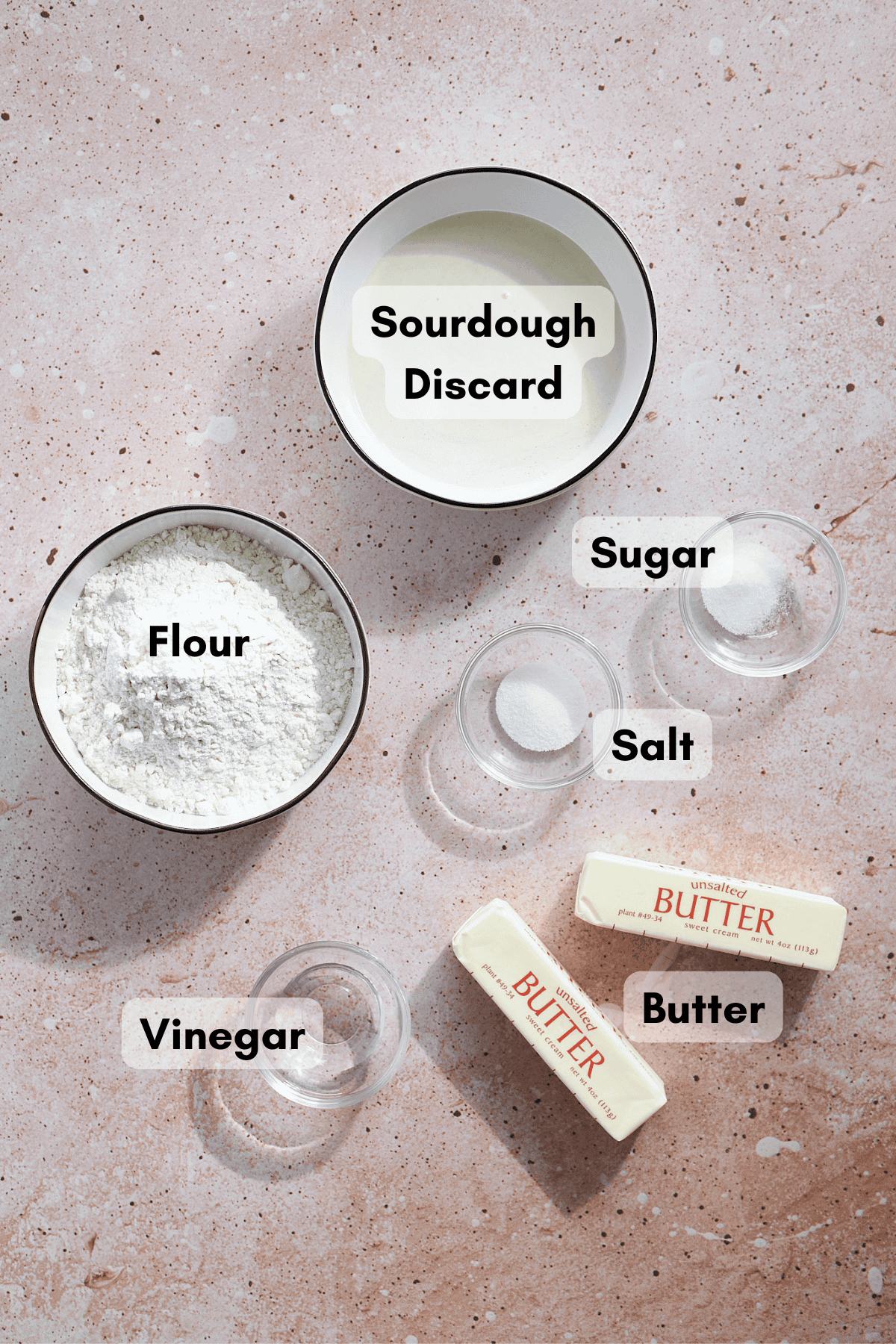
- Butter: You want your butter to be as cold as possible. I like to cut the butter into cubes (cold, straight from the fridge), then freeze the cubed butter for at least 15 minutes before mixing with the dry ingredients.
- Sourdough discard: The sourdough discard should be unfed, and cold, right from the fridge! Again, we want to keep ingredients as cold as possible. This recipe is designed for a sourdough starter with a 1:1 ratio (when you feed your starter, it's with 1 part flour and 1 part water). If your starter uses a different ratio, you may need to adjust some of the ingredients in this recipe.
- Learn more about how to make a sourdough starter.
- Vinegar: I prefer to use distilled white vinegar for a pie crust, but you can also use apple cider vinegar for a slightly different flavor.
See full recipe below for detailed directions.
Substitutions & Variations
Since pie crust is the base of so many wonderful recipes, there are only a few variations that can be made here:
- Use active sourdough starter - While it's not needed for leavening, you can use active sourdough starter if you prefer. To do so, replace the sourdough discard with active starter (200g). All other ingredients remain the same.
- Use apple cider vinegar - Instead of distilled white vinegar, use apple cider vinegar for a slightly different flavor profile.
- Egg wash substitute - If you are not baking with eggs, you can brush the crust with a little milk or non-dairy milk. Ultimately, you can also skip the egg wash completely!
- Looking for other sourdough discard dessert recipes? Try these Sourdough Discard Cinnamon Rolls and this Sourdough Discard Apple Pull Apart Bread.
I have not tested this recipe with other variations, but if you do, let us know how it turns out in the comments! I always love to hear how you're adapting these recipes and use those as ideas for future recipes as well!
How to Make Sourdough Discard Pie Crust
Working quickly and keeping the butter (and the dough) cool is key. There are just a few steps to bring this pie crust together!
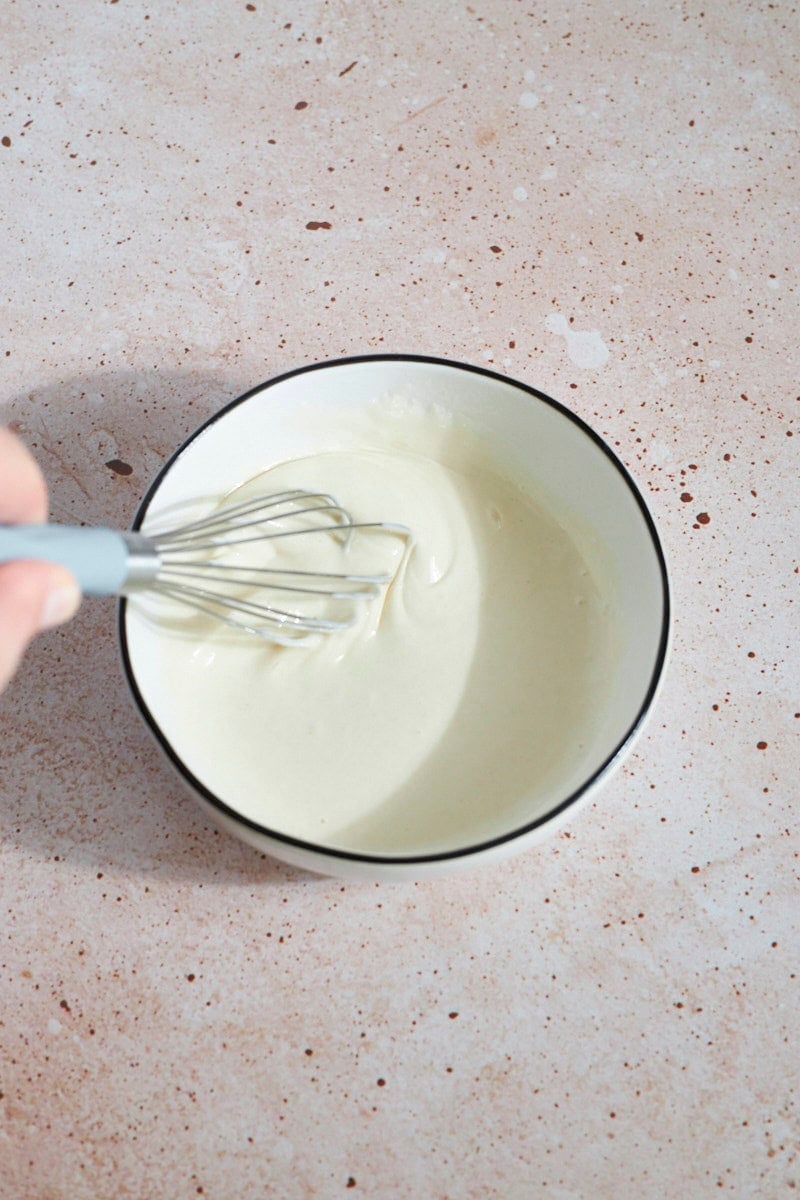
- Step 1: Mix the sourdough discard and vinegar together in a small bowl. Refrigerate until you are ready to use.
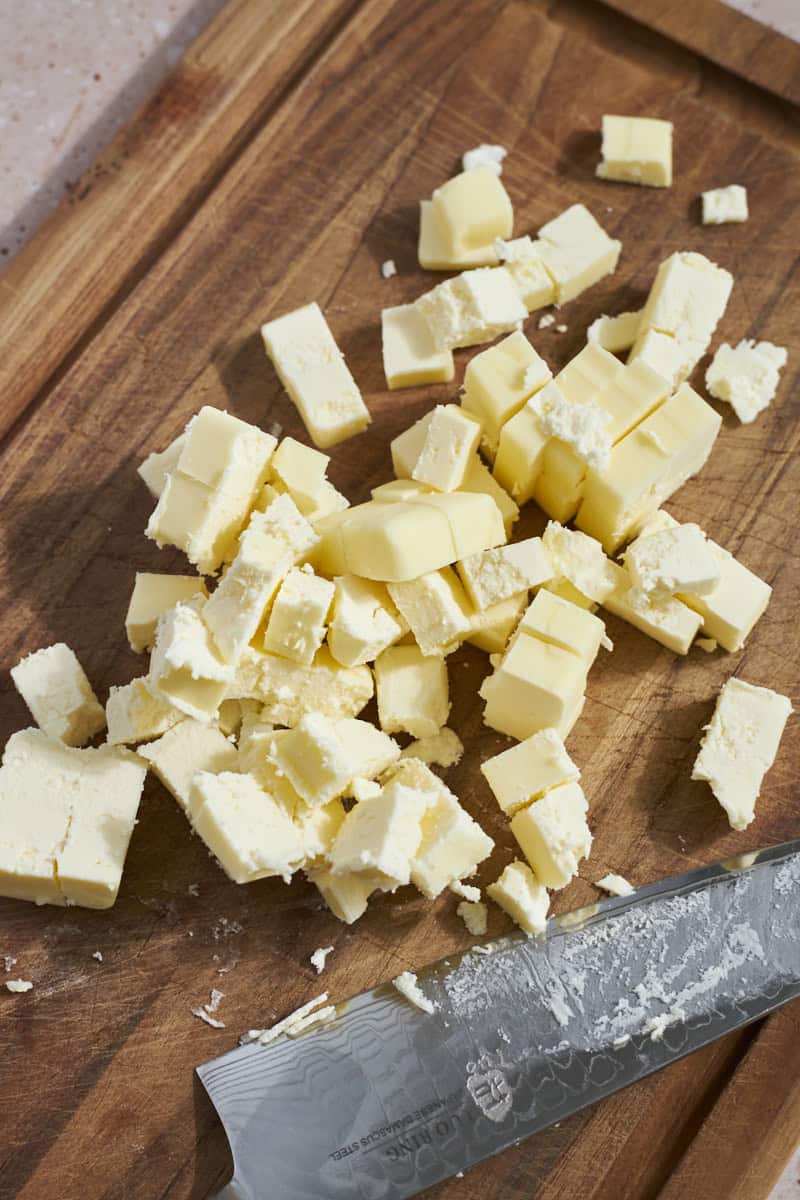
- Step 2: Cut the butter into small cubes. Return the butter to the refrigerator (or freezer) until you are ready to use.

- Step 3: Combine the dry ingredients, then add the butter. Use a pastry cutter or your hands to mix together until you have a coarse mixture. Butter chunks should be pea-sized; do not overmix.
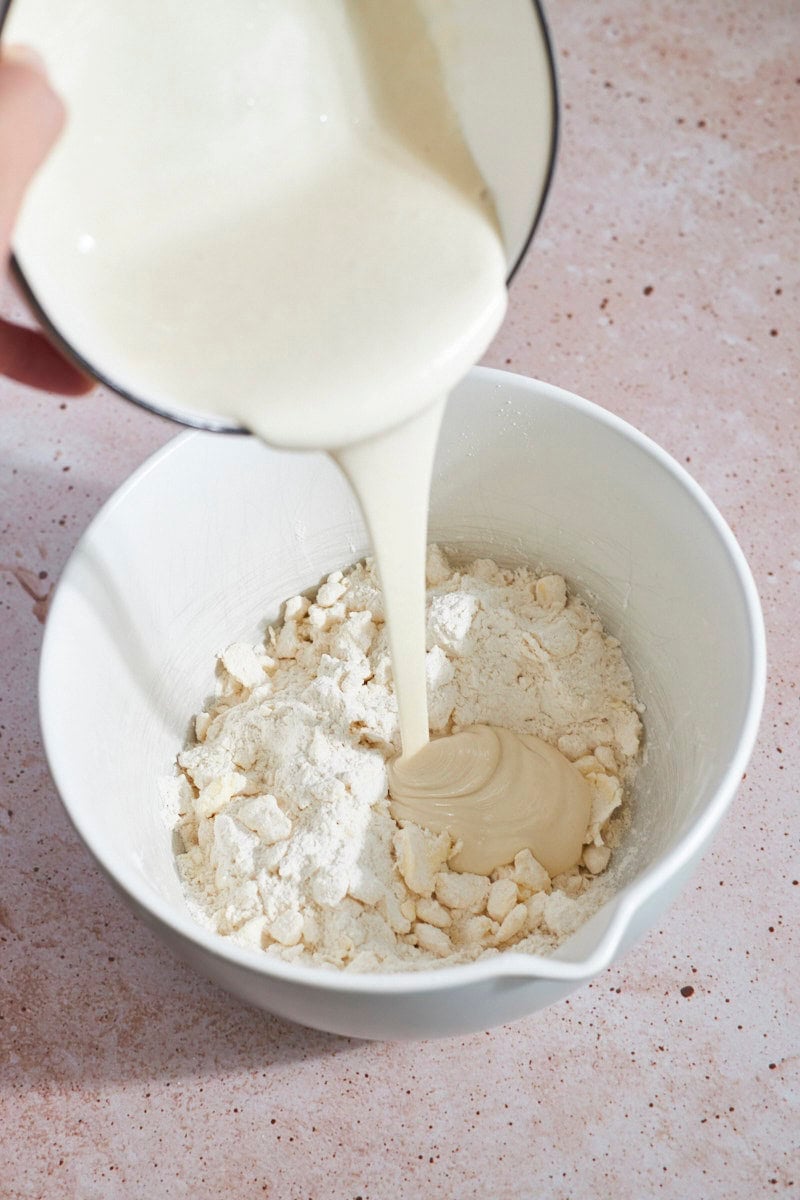
- Step 4: Add the sourdough discard mixture.
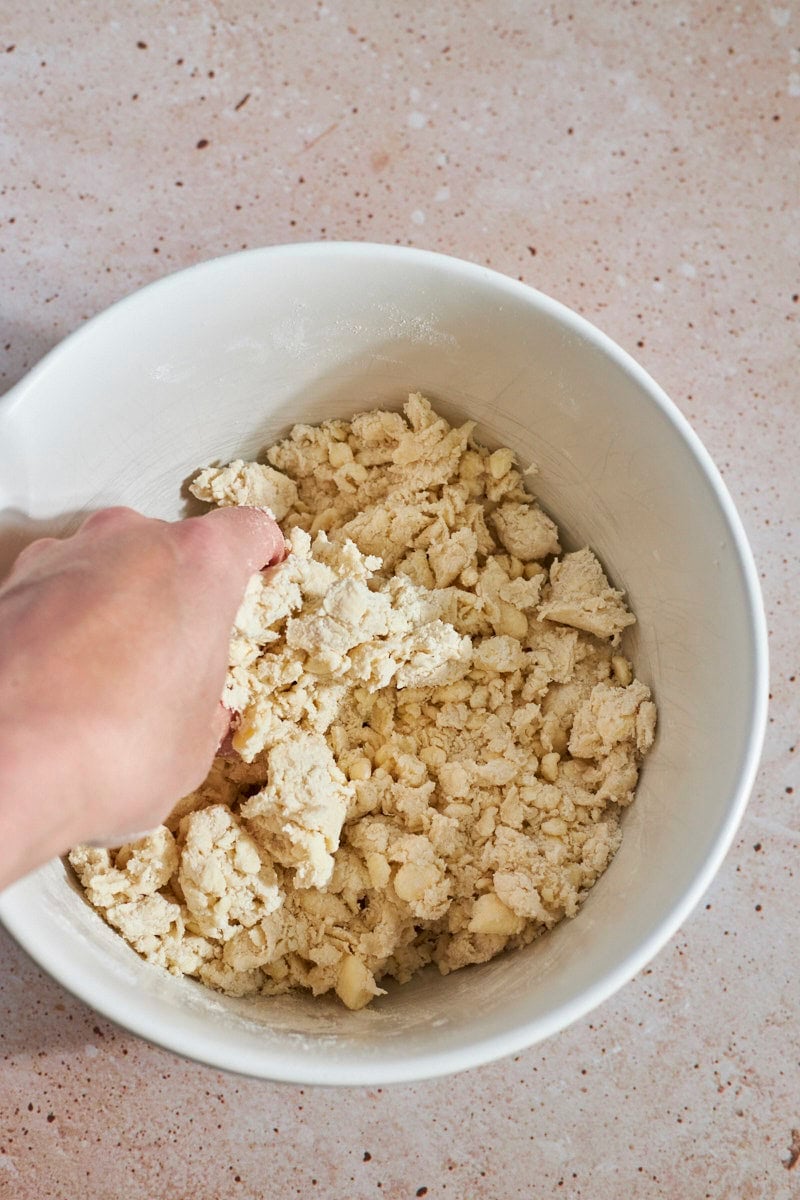
- Step 5: Use your hands, a pastry cutter or a fork to mix. It will be shaggy and clumpy, and you should still see chunks of butter (it's a good thing!). Again, be careful not to overmix.
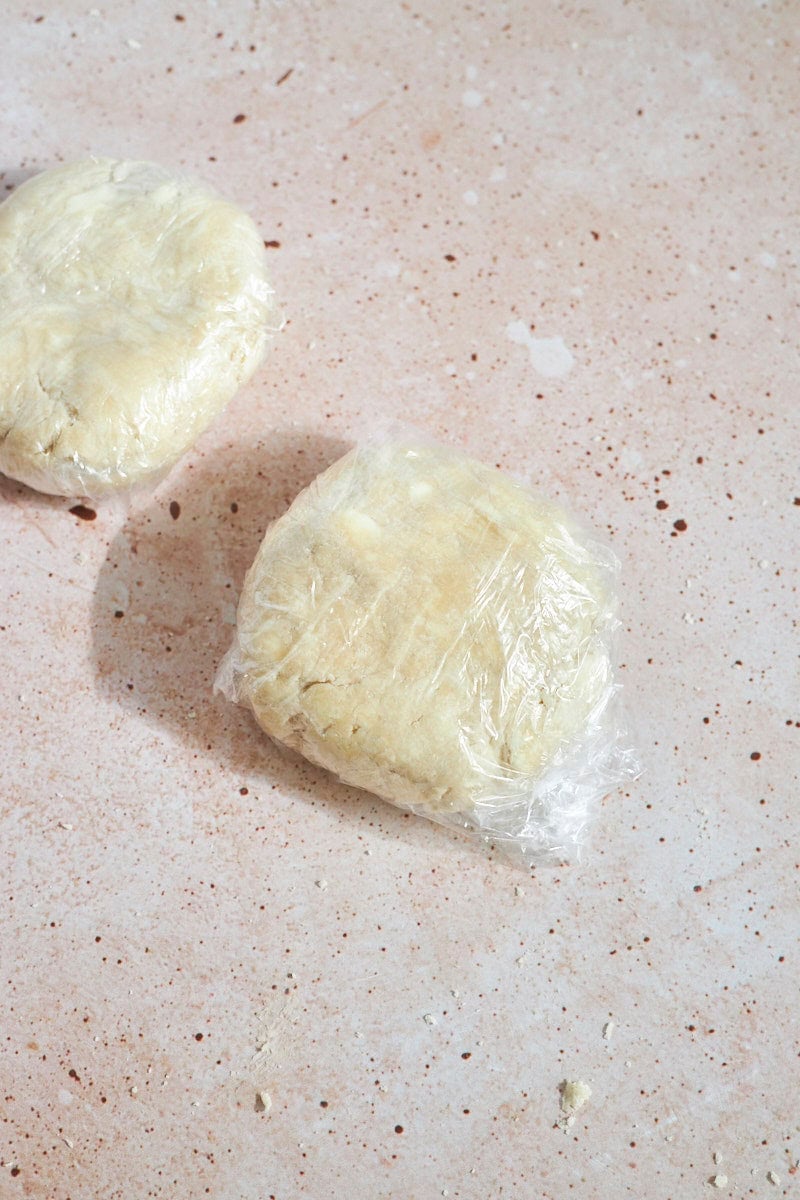
- Step 6: Gather the dough into a rough ball, then use a knife to divide in half. Wrap each piece in plastic wrap and refrigerate for at least 2 hours. Note: If you intend to freeze the dough, place the plastic wrapped dough into a freezer-safe bag and freeze for up to 3 months.
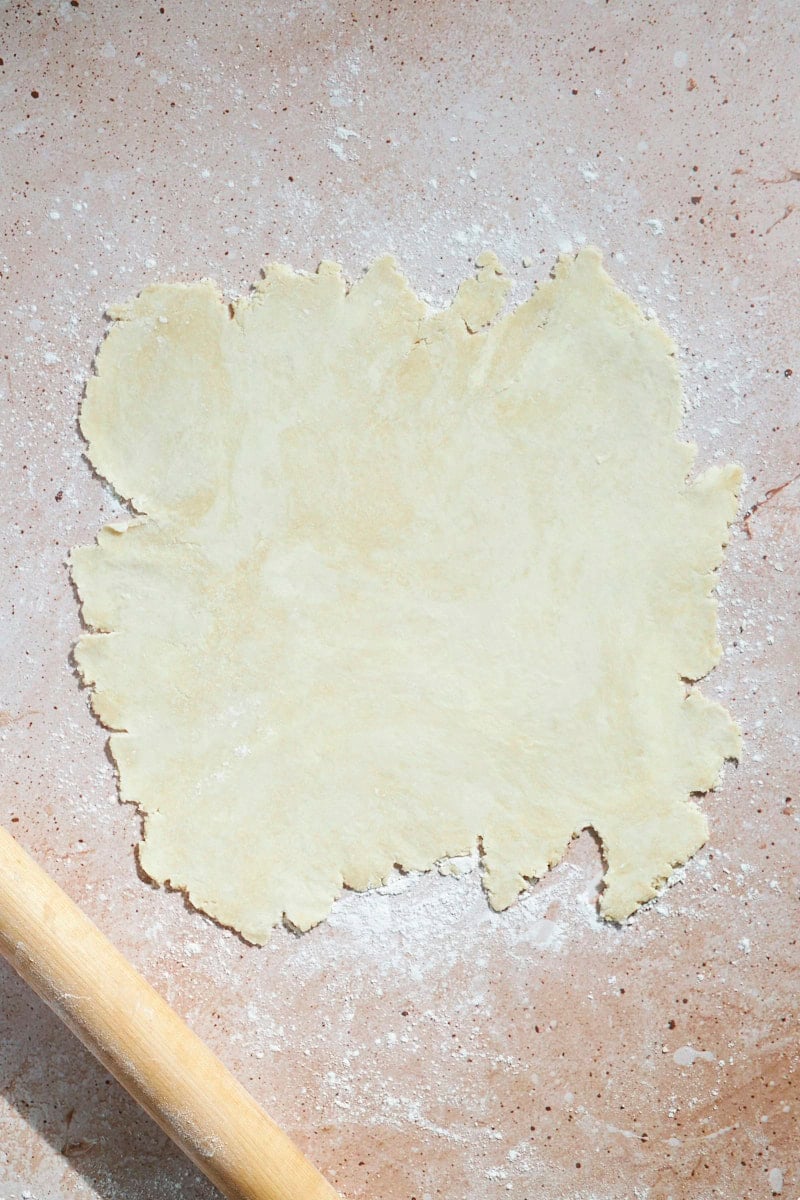
- Step 7: Roll the dough into a rough circle.
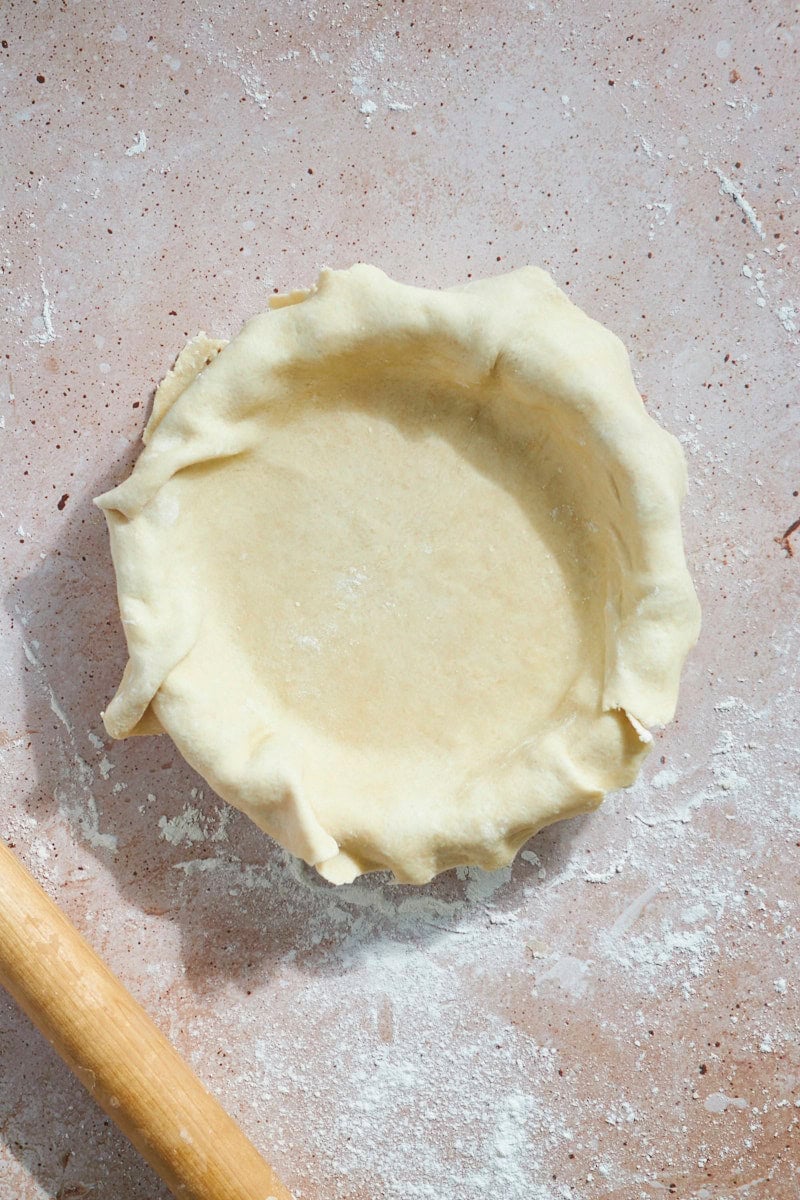
- Step 8: Transfer the dough to your pie dish (or baking sheet, if using).
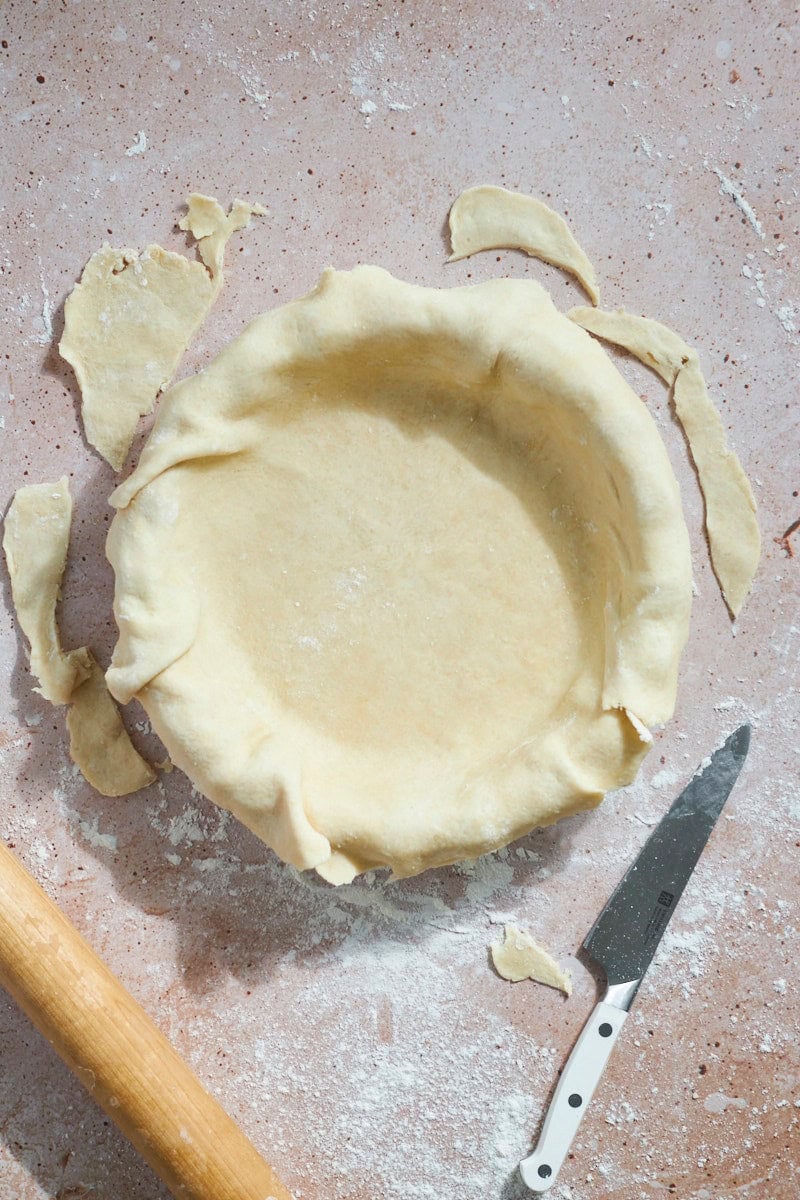
- Step 9: Trim the edges, leaving 2 inches of excess to allow for crimping.
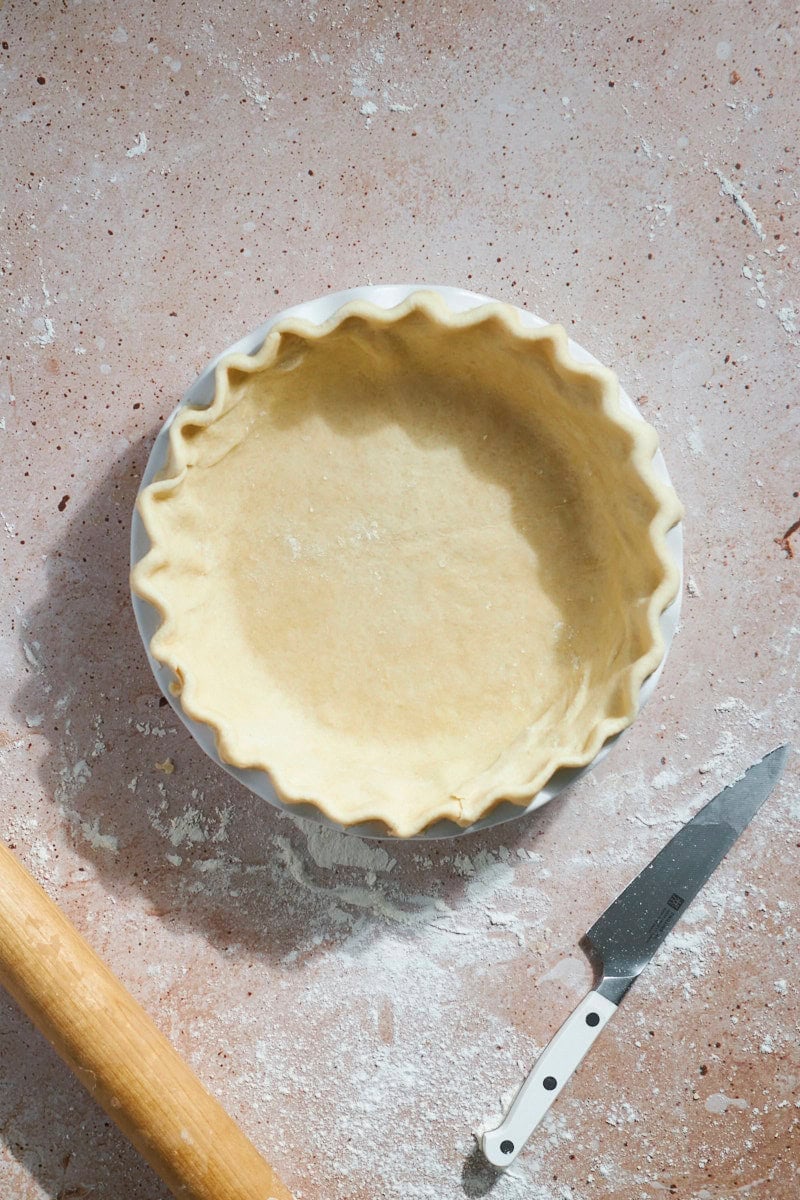
- Step 10: Crimp and shape the edges. You're now ready to fill or bake per your recipe's instructions!
Expert Baking Tips
- Keep the butter as cool as possible. Freezing the butter before you add it to the dry ingredients can be helpful.
- You can make the dough by hand, or using a pastry cutter or fork to bring the dough together.
- If the dough feels sticky at any point (the butter is warming), put it back in the fridge for 15 minutes and then continue again.
- Unlike working with sourdough bread recipes, there is no kneading for this dough. It can be hard to resist, but don't overwork the dough!
- This is similar to making Sourdough Discard Scones - you don't want to knead the dough too much!
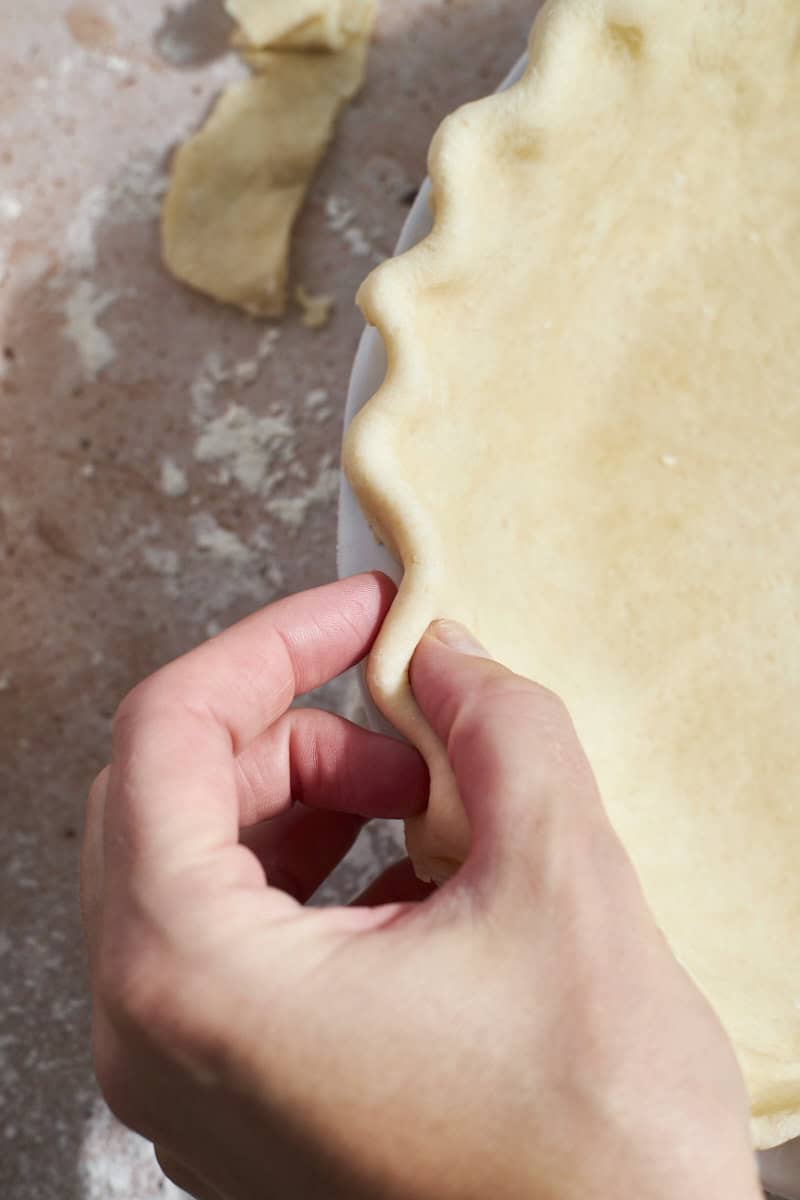
What should you use to mix this dough?
There are several ways to mix pie dough. None is necessarily the "correct" or a "better" way. Use what works best for you!
- Mix by hand: I love to mix pie dough by hand. It really allows you to feel the texture and leave some irregularity (different-sized butter pieces, for example) that can be wonderful. You're also less likely to overwork dough when mixing by hand rather than when using something like a food processor. That said, it can be messy, and your hands will warm the butter more than if you're using a pie cutter or fork for mixing.
- Mix with a pastry cutter: This is a great way to mix dough to minimize the warmth from your hands. You'll still get some irregularity in the butter pieces, which is ideal.
- Mix with a fork: Similar to using a pastry cutter, mixing with a fork minimizes the warmth from your hands affecting the butter.
- Mix with a food processor: This is a great option for making the dough quickly and minimizing warmth from your hands. But it doesn't allow for any irregularity (everything will be uniform) and there is the risk of overworking the dough, which is easy to do with a machine.
How should you bake this pie crust?
Ultimately, you will want to follow the directions for whatever dessert you are making in order to bake this crust. For reference, below are a few different ways it can be baked:
- Par-baking is partially baking the pie crust before filling. Par-baked crusts are for pies with fillings that need to be cooked in the oven (like a pumpkin pie).
- Method: Use a fork to prick holes in the bottom of the crust. Line with a piece of parchment paper, then fill the crust with pie weights (or dried beans or rice). Bake at 425 degrees F for 10-15 minutes. The dough will still be pale, but will not look raw.
- Blind-baking is completely baking the pie crust before adding the filling. Blind-baked crusts are for pies with fillings that do not need to be cooked in the oven (like a banana cream pie).
- Method: Use a fork to prick holes in the bottom of the crust. Line with a piece of parchment paper, then fill the crust with pie weights (or dried beans or rice). Bake at 425 degrees F for 15-17 minutes until the bottom is evenly browned.
- A Double Crust Pie has a crust on top as well as the bottom (like an apple pie).
- Method: Bake at 400 degrees F for 35-40 minutes until the crust is golden and the filling is bubbly.

kitchen essentials
My Favorite Pie Dish
If you're looking for a statement ceramic pie dish, this is the one!
Storage
Refrigerator Storage: You can make this pie crust in advance and keep it in the refrigerator for up to 2-3 days. To do so, shape the dough into a slightly flattened ball and wrap with plastic wrap. When you're ready, roll out the dough for your dessert as needed.
Freezer Storage: You can freeze pie crust for up to 3 months. To do so, shape the dough into a slightly flattened ball and wrap with plastic wrap. Then, place the wrapped dough in a freezer-safe bag (you want to prevent any freezer burn) and freeze for up to 3 months.
When you're ready to use the dough, let it thaw overnight in the refrigerator, then roll out the dough for your dessert as needed.
Recipe FAQs
If your dough seems "springy" and is bouncing back while you're rolling it out, the gluten has been activated and is reacting to being stretched. This is a sign that your dough is overworked.
Cover the dough with plastic wrap and let sit for a few minutes, then try again. If needed, put the dough back in the refrigerator to keep it from getting too warm. Even if your dough is overworked, it will still taste great!
If your dough is a bit sticky, it may stick to the rolling pin. This can happen if your dough is too warm and the butter is starting to melt. You have two options: 1) sprinkle the rolling pin with flour to help prevent sticking. 2) Place the dough back in the refrigerator for 10-15 minutes, then try again.
Yes, you can make the dough and keep it in the refrigerator for up to 2-3 days, or in the freezer for up to 3 months. When you're ready to use it, thaw in the fridge overnight (if frozen), then roll it out for your dessert as needed.
Yes, you can. To do so, replace the sourdough discard with active sourdough starter (200g). All other ingredients remain the same.
Sourdough discard is what you have left over after you feed your sourdough starter. You can either literally discard it (throw it away, or compost it), or use it in sourdough discard recipes like this one.
More Sourdough Discard Dessert Recipes
If you tried this Sourdough Discard Pie Crust or any other recipe on my website, please leave a ⭐ star rating and let me know how it went in the comments below. I'd love to hear from you! Happy Baking!

Sourdough Discard Pie Crust
Ingredients
- 200 grams (about ¾ cup) sourdough discard unfed and cold, straight from the refrigerator
- 2 teapsoons distilled white vinegar
- 1 ¾ cup all-purpose flour
- 1 teaspoon kosher salt
- 1 teaspoon granulated sugar
- 1 cup unsalted butter cold, cut into small cubes
Instructions
- In a small bowl, combine the sourdough discard and vinegar and mix until smooth. Place the bowl in the refrigerator until you're ready to use it.
- In a large bowl, whisk together flour, salt and sugar. Add the cubed butter and use your hands or a pastry cutter to mix together until you have a coarse mixture. If mixing by hand, use your fingers to press and smash the cubed butter and coat it with the flour. Butter chunks should be pea-sized; do not overmix.
- Add the sourdough discard mixture and use the pastry cutter or a fork to mix the dough just until combined. It will be shaggy and clumpy, and you should still see chunks of butter (it's a good thing!). Again, be careful not to overmix.
- Pour the dough mixture onto a smooth work surface. Gather the dough together (be careful - we're not kneading the dough, just gathering) into a ball). If the dough seems too dry, add a little water (¼-½ teaspoon). If it seems sticky, add a sprinkle of flour. The dough should not be sticking to the work surface.
- Divide the dough into two pieces, wrap each in plastic wrap, and press into a disk. Chill in the refrigerator for at least 2 hours.
- After chilling, transfer one of the dough disks to a lightly floured work surface. Use a lightly floured rolling pin to evenly roll the dough into a roughly 12-inch circle (ideal for a 9-inch pie crust), or the size and shape needed for your dessert recipe.
- To transfer your crust to the pie pan or baking sheet, roll the dough onto your rolling pin. Hold one end of the circle of dough to your rolling pin, and gently roll the pin, wrapping the dough around the pin on itself (a little extra sprinkling of flour here can keep the dough from sticking to itself, if needed). Move the pin to your pie pan or baking sheet, place the end of the dough at the edge of the dish, and unroll the dough off the pin.
- Fill and bake your pie or dessert according to your recipe's instructions, rolling out the second crust when needed.

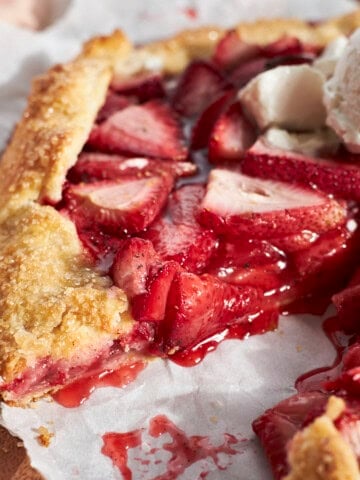
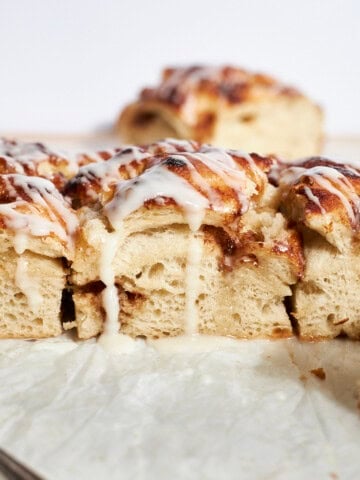
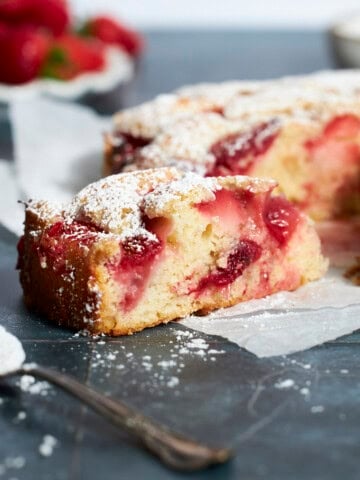
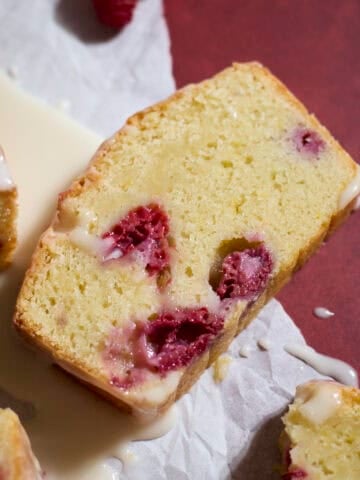
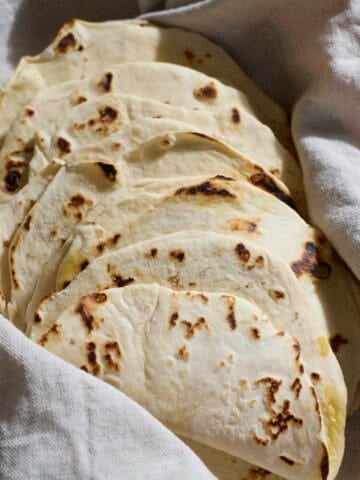
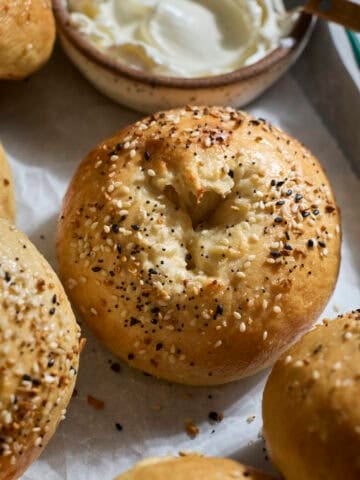
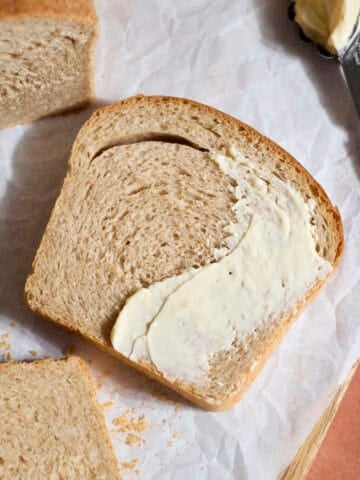
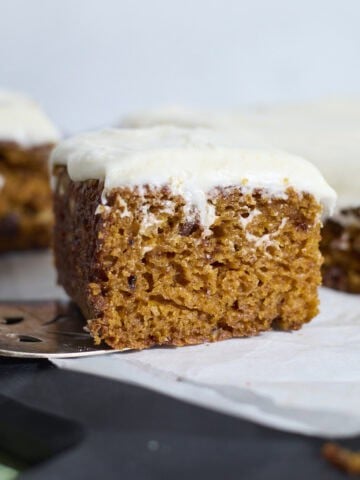
Kayla Graf-Davis says
hello! I am about to use this recipe for the first time. I was wondering if I would be able to complete and shape the crust and then refrigerate for 3 days instead of just leaving it as a ball?
Jessica Vogl says
That's a good question! I would recommend refrigerating in a ball, but this could possibly work, I just haven't tried it!
C says
Can I use olive oil instead of butter?
Jessica Vogl says
I haven't tried it but I don't think that will work.
Jenny says
Would it work if I used less Butter?
Jessica Vogl says
Unfortunately not!
Alana Morris says
Would it be ok to let the dough disc stay refrigerated for 24 hours?
Jessica Vogl says
Yes, that should be fine!
Kat says
Wondering what the vinegar does in this recipe?
Christy Messina says
Amazing Jess, I used this for English Cornish pasties, cheese and onion pastries and galettes it’s perfect !
Nancy Mock says
This is a great pie crust recipe! I had never heard of using discard in pie dough before, so I was really intrigued. The dough came together easily and baked up crispy, flaky, and light—I used it in for a sweet galette as well as a savory tart. A nice bonus was that the crust smelled a little like sourdough bread as it baked! One tip is that on humid days like I had you can get away with adding a little less of the discard-vinegar liquid to the mixture. I'll definitely use this recipe again. Thanks, Jess!
Jessica Vogl says
Amazing, so glad you loved it!